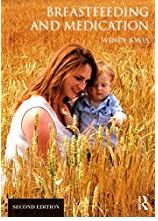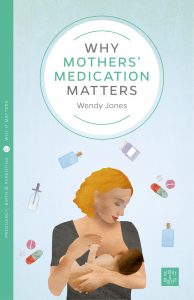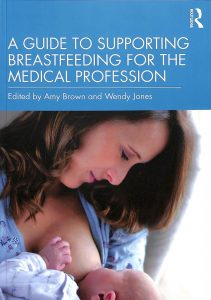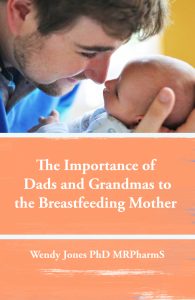Home » 2020
Yearly Archives: 2020
Fibromyalgia and Breastfeeding
Fibromyalgia is incredibly difficult to deal with when you have a baby. The most effective intervention is CBT. Please read this factsheet which is a chapter from my book Breastfeeding and chronic medical conditions available on amazon https://tinyurl.com/mbbebe8x
Breastfeeding and Fibromyalgis factsheet

Who am I and how did I come to set up this website?
Recently whilst writing the planned book (hopefully coming soon) I decided to update the section on the website about “Who Am I?” It is about how I came to have this passion and to write my books and the inspiration and support of my husband, my girls and my grandchildren.
I hope it explains a little more about what drives me to do this 18 hours a day 365 days a year.

Books to buy
Do you want to buy a copy of one of my books? They are all available on Amazon which is probably easiest. Or direct from the publishers Routledge, Pinter and Martin, Praeclarus Press or Kindle . I’m not going to available as much in the future to answer questions so maybe now is the time to buy the books so you have answers 24/7 365 days a year.

Stillbirth and Milk Supply
Following on from the information on miscarriage I decided I needed to carry on talking about the hardest topics for mothers and think about the unthinkable – stillbirth, a baby born sleeping, and how to deal with the subsequent milk supply. I could fervently wish this never needed to be read but I hope that it provides information for mothers, families and professionals in this awful situation.
stillbirth and milk supply factsheet

Lack of stools / constipation in a breastfed baby
Constipation in the neonate is a topic apparently rarely discussed in medical sources and may be seen as the domain of the health visitor or midwife. However, many “constipated” babies may be seen by their GP and be the cause of concern for their parents.
This factsheet is designed to provide information for parents and their professionals on what is normal with regard to baby poo and where interventions are required be that referral to breastfeeding expert or medical treatment.
Lack of stool/constipation in the breastfed baby

Turmeric supplements and breastfeeding
Turmeric is a supplement recommended for the relief of inflammation in many chronic conditions. It is, of course, a spice used in curries.
When taken as a supplement levels are significantly higher than those used for culinary purposes.
This is the information on compatibility with breastfeeding that I found in LactMed
https://www.ncbi.nlm.nih.gov/books/NBK501846/ (the emphasis is my own) :
Summary of Use during Lactation
Turmeric (Curcuma longa) rhizome contains curcuminoids such as curcumin. No data exist on the excretion of any components of turmeric into breastmilk or on the safety and efficacy of turmeric in nursing mothers or infants. Turmeric is “generally recognized as safe” (GRAS) as a food ingredient by the U.S. Food and Drug Administration. Turmeric is generally well tolerated even in high doses, but gastrointestinal side effects such as nausea and diarrhea, and rare allergic reactions have been reported, and it may increase the risk of bleeding in patients taking warfarin and antiplatelet drugs.
Because of a lack of data, turmeric in amounts higher than those found in foods as a flavoring should probably be avoided during breastfeeding.
Turmeric has been used as a galactogogue in India;[1][2] however, no scientific data support this use. In Thailand it is reportedly used as part of a topical herbal mixture to shorten the time to full lactation and also part of a topical herbal mixture used for breast engorgement.[3][4] Galactogogues should never replace evaluation and counseling on modifiable factors that affect milk production.[5] In India turmeric is a component of a paste applied to the breasts for sore nipples.[6] Contact dermatitis has been reported after contact of the skin with curcumin-containing products.[7]
References from LactMed https://www.ncbi.nlm.nih.gov/books/NBK501846/
1.Sayed NZ, Deo R, Mukundan U. Herbal remedies used by Warlis of Dahanu to induce lactation in nursing mothers. Indian J Tradit Knowl. 2007;6:602-5.2.Chaudhuri RN, Ghosh BN, Chatterjee BN. Diet intake patterns of non-Bengali Muslim mothers during pregnancy and lactation. Indian J Public Health. 1989;33:82-3. [PubMed]3.Dhippayom T, Kongkaew C, Chaiyakunapruk N et al. Clinical effects of Thai herbal compress: A systematic review and meta-analysis. Evid Based Complement Alternat Med. 2015;2015:942378. [PMC free article] [PubMed]4.Ketsuwan S, Baiya N, Paritakul P et al. Effect of herbal compresses for maternal breast engorgement at postpartum: A randomized controlled trial. Breastfeed Med. 2018;13:361-5. [PubMed]5.Brodribb W. ABM Clinical Protocol #9: Use of galactogogues in initiating or augmenting maternal milk production, second revision 2018. Breastfeed Med. 2018;13:307-14. [PubMed]6.Amuthavalluvan V, Devarapalli J. Indigenous knowledge and health seeking behavior among Kattunayakan: a tribe in transition. Glob J Human Soc Sci. 2011;11. http://socialscienceresearch.org/index.php/GJHSS/article/view/198/161.7.Chaudhari SP, Tam AY, Barr JA. Curcumin: A contact allergen. J Clin Aesthet Dermatol. 2015;8:43-8. [PMC free article] [PubMed]
Retinoid beauty creams and breastfeeding
With the launch of a new beauty cream containing retinol advertised as reducing wrinkles, the questions about beauty products similar to it have increased. Or maybe we all just need something to cheer us up during Lockdown.
There is no research on the use of topical retinols and the best information I have sourced is “Because it is poorly absorbed after topical application, it is considered a low risk to the nursing infant” (Lactmed accessed June 2020 studies referenced below.)
Hale (Medications and Mother’s Milk accessed June 2020 states “Tretinoin is a retinoid derivative similar to Vitamin A. It is primarily used topically for acne and wrinkling and sometimes psoriasis. Used topically, tretinoin stimulates epithelial turnover and reduces cell cohesiveness.[1] Blood concentrations measured 2-48 hours following application are essentially zero.
I have been unable to access the full papers and so would recommend caution
They
- Leachman SA, Reed BR. The use of dermatologic drugs in pregnancy and lactation. Dermatol Clin. 2006;24:167-97. [PubMed]
- Zip C. Common sense dermatological drug suggestions for women who are breast-feeding. Skin Therapy Lett. 2002;7:5-7. [PubMed]
- Butler DC, Heller MM, Murase JE. Safety of dermatologic medications in pregnancy and lactation: Part II Lactation. J Am Acad Dermatol. 2014;70:417.e1-417.e10. [PubMed].
- Zbinden G. Investigation on the toxicity of tretinoin administered systemically to animals. Acta Derm Verereol Suppl(Stockh) 1975; 74:36-40.
- Lucek RW, Colburn WA. Clinical pharmacokinetics of the retinoids. Clin Pharmacokinet 1985; 10(1):38-62

Infliximab and breastfeeding
Following on from the page on Azathioprine I thought it would be useful to add data on infliximab which is also widely used by breastfeeding mothers. Like most of the biologicals the molecules are too large to pass into milk.
This information is taken from Breastfeeding and Medication
In 2002, the NICE (NICE 2002) recommended that this drug be only used for the treatment of severe, active CD when treatment with immunosuppressant drugs and corticosteroids is not tolerated or has failed.
It is now much more commonly prescribed to pregnant and breastfeeding women.
Infliximab is a large molecular weight antibody and preliminary results suggest it is too large to pass into breastmilk and it is not orally bio-available. It is distributed primarily in the vascular compartment and has a terminal elimination half-life of 8 to 9.5 days.
It is suggested that use by a mother should not preclude breastfeeding based on this data (Peltier 2001; Forger 2004; Mahadevan 2005; Basilisks 2006).
The BNF states that the amount in breastmilk is too small to be harmful.
Infliximab is usually either not detectable in breastmilk or detectable at very low levels. Absorption of the drug from milk by the infant is minimal. Follow-up of infants exposed in utero and breastfed during maternal infliximab therapy have found no adverse effects and normal development. The measurement of minute concentrations in the milk of some women raises the possibility of local immune suppression in the gastrointestinal tact, but levels were not high enough to be of concern for systemic immunosuppression (LactMed)
References
- Forger F, Matthias T, Oppermann M Becker H, Helmke KInfliximab in breastmilk, Lupus, 2004;13:753. Abstract NICE Crohns Disease – infliximab 2002
- Mahadevan U, Kane S, Intentional infliximab use during pregnancy for induction or maintenance of remission in Crohn’s disease, Aliment Pharmacol Ther, 2005;21:733–8.
- Peltier M, James D, Ford J, Wagner C, Davis H, Hanauer S Infliximab levels in breastmilk of a nursing Crohn’s patient, Am J Gastroenterol, 2001;96(9 Suppl. 1):S312. Abstract.
- Vasiliauskas EA, Church JA, Silverman N, Barry M, Targan SR, Dubinsky MC, Case report: evidence for transplacental transfer of maternally administered infliximab to the new born, Clin Gastroenterol Hepatol, 2006;4:1255–8.

Any queries please contact me on wendy@breastfeeding-and-medication.co.uk
If you have IBD or have an interest in it please join the facebook page https://www.facebook.com/groups/BreastfeedingIBD/
Azathioprine and breastfeeding
I frequently get asked about the compatibility of azathioprine during breastfeeding . It is used for several auto-immune diseases including inflammatory bowel disease and sometimes rheumatoid arthritis. It is actually quite widely taken by breastfeeding mothers from the questions I receive.
This information is taken from Breastfeeding and Medication
“Azathioprine is an immunosuppressive anti-metabolite. It is converted to mercaptopurine in the body. It has a corticosteroid-sparing effect and is widely used to produce and maintain remission in IBD, as well as conditions such as lupus and rheumatoid arthritis.
Traditionally, breastfeeding by mothers have been discouraged from continuing to breastfeed if taking azathioprine because of the theoretical risks of infant bone marrow suppression, susceptibility to infection, growth retardation and pancreatitis.
According to recent research (Gardiner et al. 2007) breastfeeding need not be withheld in infants whose mothers are taking azathioprine. Gardiner et al. studied four mothers taking azathioprine. The metabolites 6-MP and 6-TGN were undetectable in neonatal blood and no clinical signs of immunosuppression were observed in the infants. Similarly Moretti et al. (2006) studied four babies and measured levels of 6-MP in breastmilk and neonatal blood for drug levels, white cell and platelet counts. Levels of metabolites were below the level of detection in the neonates and no clinical signs of immunosuppression were observed. Sau et al. (2007) studied ten women and similarly found no immunosuppression. Women taking azathioprine should therefore not be discouraged from breastfeeding.
It is licensed to be given to children over the age of 2 years at a dose of 2 mg per day initially for severe UC and CD. Relative infant dose is quoted as 0.07% to 0.3% (Hale 2017 online access).
The BNF states that it is present in milk in low concentrations, that there is no evidence of harm in small studies and the drug may be considered if the potential benefit outweighs the risk.
- Gardiner SK, Gearry RB, Roberts RL, Zhang M, Barclay ML, Begg EJ, Exposure to thiopurine drugs through breastmilk is low based on metabolite concentrations in mother-infant pairs, Br J Obstet Gynecol, 2007;114:498–501.
- Sau A, Clarke S, Bass J, Kaiser A, Marinaki A, Nelson-Piercy C, Azathioprine and breastfeeding – is it safe?, BJOG, 2007;114:498–501.
- Moretti ME, Verjee Z, Ito S, Koren G, Breastfeeding during maternal use of azathioprine, Ann Pharmacother, 2006;40:2269–72.
- Hale TW Medications and Mother’s Milk”

Any queries please contact me on wendy@ breastfeeding-and-medication.co.uk
For mothers with IBD, or professionals with an interest please join our Facebook page https://www.facebook.com/groups/BreastfeedingIBD/
Perinatal Mental Health in pregnancy and breastfeeding
I saved this presentation to share during UK Maternal Mental Health Awareness Week which is this week. It is a presentation which I have on my last study day on my birthday this year. I hope it covers many of the things I have tried to pass on over the years.
I also post it today in honour of my daughter who is a CBT therapist and has helped me learn so much along my own journey into understanding mental health. She gave birth to a gorgeous, if tiny, little girl this morning – my sixth grandchild who I cannot see in person during this crazy, demanding time in our lives. I think the COVID-19 pandemic has played with the minds of many of us.
I hope this presentation helps with CPD and I am happy to answer any questions via email wendy@breastfeeding-and-medication.co uk.
Mental health in pregnancy and breastfeeding powerpoint
If it is useful there are 2 books you might find valuable.






